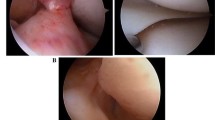Abstract
Magnetic resonance imaging (MRI) is frequently used in the diagnosis of anterior cruciate ligament (ACL) and meniscal injuries. The aim of this retrospective study was to determine the reliability and value of MRI in our management of ACL and meniscal tears. 138 patients who had undergone a MRI to confirm or refute the clinical diagnosis of an ACL or meniscal tear were identified. Those who had subsequently undergone arthroscopy were selected. MRI findings and clinical diagnosis were compared with those at arthroscopy. Sensitivity, specificity, positive predictive value (PPV), negative predictive value (NPV) and overall accuracy of clinical diagnosis and MRI were then calculated. The overall accuracy for MRI was 91, 68 and 86% for detecting ACL, medial meniscal and lateral meniscal tears, respectively. Accuracy for clinical diagnosis was 90 and 64% for ACL and meniscal tears, respectively. In contrast to other series, our results indicate a lower accuracy of MRI in detecting pathology, especially of the ACL and medial meniscus. We noted a low sensitivity, specificity and positive predictive value but a high negative predictive value rendering MRI most useful as a negative diagnostic tool. We suggest that where symptoms and clinical findings support one of these diagnoses and arthroscopic therapeutic intervention is contemplated, that MRI scanning is not always beneficial. Our current practice of requesting scans to routinely confirm the diagnosis should be altered. Unnecessary MRI scanning increases the financial burden and delays patient treatment.
Similar content being viewed by others
References
Alioto RJ, Browne JE, Barnthouse CD, Scott AR (1999) The influence of MRI on treatment decisions regarding knee injuries. Am J Knee Surg 12(2):91–97
Barronian AD, Zoltan JD, Bucon KA (1989) Magnetic resonance imaging of the knee: correlation with arthroscopy. Arthroscopy 5(3):187–191
Benjaminse A, Gokeler A, van der Schans CP (2006) Clinical diagnosis of an anterior cruciate ligament rupture: a meta-analysis. J Orthop Sports Phys Ther 36(5):267–288
Brooks S, Morgan M (2002) Accuracy of clinical diagnosis in knee arthroscopy. Ann R Coll Surg Engl 84(4):265–268
Carmichael IW, MacLeod AM, Travlos J (1997) MRI can prevent unnecessary arthroscopy. J Bone Joint Surg Br 79-B(4):624–625
Chissell HR, Allum RL, Keightley A (1994) MRI of the knee: its cost-effective use in a district general hospital. Ann R Coll Surg Engl 76(1):26–29
Dandy DJ (1997) Arthroscopy and MRI for the knee. J Bone Joint Surg Br 79-B(4):520
Feller JA, Webster KE (2001) Clinical value of magnetic resonance imaging of the knee. ANZ J Surg 71(9):534–537
Jackson DW, Jennings LD, Maywood RM, Berger PE (1988) Magnetic resonance imaging of the knee. Am J Sports Med 16(1):29–38
Lee JK, Yao L, Phelps CT, Wirth CR, Czajka J, Lozman J (1988) Anterior cruciate ligament tears: MR imaging compared with arthroscopy and clinical tests. Radiology 166(3):861–864
Liu SH, Osti L, Henry M, Bocchi L (1995) The diagnosis of acute complete tears of the anterior cruciate ligament. Comparison of MRI, arthrometry and clinical examination. J Bone Joint Surg Br 77(4):586–588
Ostrowski JA (2006) Accuracy of 3 diagnostic tests for anterior cruciate ligament tears. J Athl Train 41(1):120–121
Miller GK (1996) A prospective study comparing the accuracy of the clinical diagnosis of meniscus tear with magnetic resonance imaging and its effect on clinical outcome. Arthroscopy 12(4):406–413
Rose NE, Gold SM (1996) A comparison of accuracy between clinical examination and magnetic resonance imaging in the diagnosis of meniscal and anterior cruciate ligament tears. Arthroscopy 12(4):398–405
Acknowledgments
We thank Mr. Kader, Mr. J. Pooley, Mr. Shankar, Dr. M. Newby and the audit department for the help rendered in this study. This project has been approved by the trust audit department and complies with the laws.
Author information
Authors and Affiliations
Corresponding author
Additional information
No funding has been received from any sources and no conflicts of interests are stated in the submission of this article.
Rights and permissions
About this article
Cite this article
Thomas, S., Pullagura, M., Robinson, E. et al. The value of magnetic resonance imaging in our current management of ACL and meniscal injuries. Knee Surg Sports Traumatol Arthrosc 15, 533–536 (2007). https://doi.org/10.1007/s00167-006-0259-7
Received:
Accepted:
Published:
Issue Date:
DOI: https://doi.org/10.1007/s00167-006-0259-7



